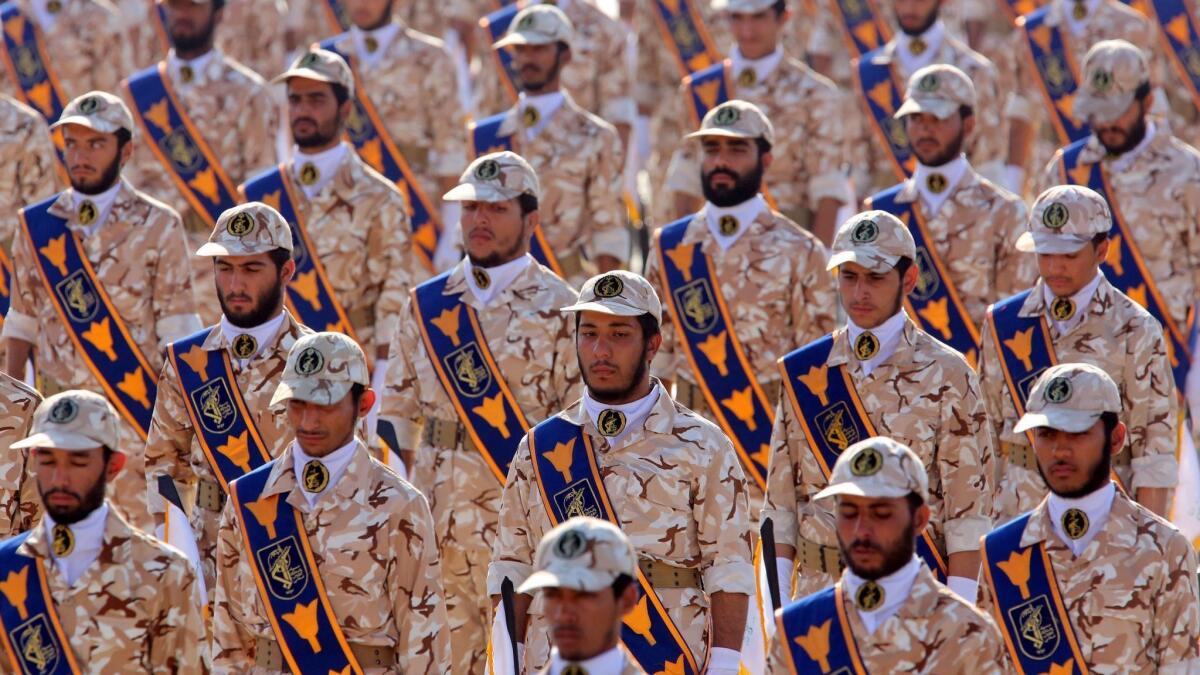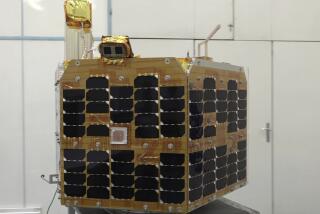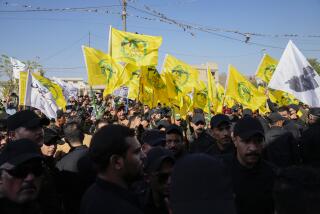What is Iran’s Revolutionary Guard Corps?

- Share via
Iran’s Islamic Revolutionary Guard Corps is one of the country’s wealthiest organizations and holds immense political, military and economic power.
Now it has a new distinction. President Trump announced Monday that his administration is designating it as a foreign terrorist organization — a first for an entire government entity.
So what exactly is the IRGC?
Here’s a look at its history and its role in Iran and abroad.
Protector of the Islamic Revolution
It was established as a grassroots organization shortly after the 1979 revolution that toppled the long-ruling monarchy and replaced it with an anti-Western theocracy. Its purpose was to safeguard the ideology of the Islamic Republic, which aimed to restrict the private sector, distribute wealth more equally and elevate the role of Shiite Islam in daily life.
Ayatollah Ruhollah Khomeini, the first supreme leader of Iran, made the Revolutionary Guard separate from the regular army because he worried there were military forces still loyal to the pro-Western deposed monarch, Mohammed Reza Shah Pahlavi, best known as the shah.
“People thought that there would be a long struggle against the shah and the Revolutionary Guards would act as resistance,” said Ariane Tabatabai, an associate political scientist at the Rand Corp. think tank.
The Revolutionary Guard played an integral role in Iran’s war with Iraq in the 1980s, a brutal conflict that helped transform it from an informal group into a professional entity.
Branches within the guard
They are the Basij militia and the Quds Force.
The Basij is made mostly up of volunteers who are fervent believers in the ideology of the Islamic Republic. It is responsible for defending the country against foreign invasion and clamping down on anti-government dissent, such as street demonstrations.
The Quds Force is tasked with missions outside of Iran’s border, some of which have been very high-profile in recent years.
In Iraq, the Quds Force has been accused of providing weapons, money and training to Shiites. And in Syria, it has commanders on the ground who provide support to President Bashar Assad against the rebels his government has been fighting since 2011.
Supporter of industries
It has a construction branch that employs more than 40,000 people and has developed projects in transportation, construction, agriculture and manufacturing industries, according to a 2018 study by the Brookings Institution in Washington.
In recent years, the group has expanded into the oil and gas sector, securing a $1.3-billion contract with the government for a domestic pipeline, the study found.
Many of the Revolutionary Guard commanders in the Iran-Iraq war later went into politics. Mahmoud Ahmadinejad, who was president from 2005 to 2013, and many of his Cabinet members had been in the Basij.
In recent years, Iranian President Hassan Rouhani has tried to curb the Revolutionary Guard’s influence. Shortly after winning reelection in 2017, Rouhani appointed a defense minister who was not closely affiliated with the Revolutionary Guard.
U.S. accusations of terrorism
The U.S. has accused the group of sponsoring foreign militants in the region for decades.
One of the earliest accusations dates to the 1994 bombing of a Jewish community center in Argentina in which more than 80 people were killed. In 2011, U.S. authorities alleged that the group assisted efforts to assassinate Saudi Arabia’s ambassador to the United States.
The Revolutionary Guard has also been accused of giving millions of dollars in arms to the Lebanese Islamic militia Hezbollah, which the State Department has designated as a foreign terrorist organization.
In his statement issued Monday, Trump said the Revolutionary Guard “actively participates in, finances, and promotes terrorism as a tool of statecraft” and is the Iranian government’s “primary means of directing and implementing its global terrorist campaign.”
No stranger to U.S. blacklists
In 2007, then-President George W. Bush accused the Quds Force of providing militants in Iraq with roadside bombs. His administration then designated the Quds Force as a terrorist group and named several of its senior leaders as human rights abusers.
Four years later, after the U.S. announced it had discovered evidence that the Quds Force had provided support to the Syrian government and the Taliban, the Treasury Department sanctioned additional senior members of the group.
More names were added in 2017.
“The IRGC has already been designated in a number of similar ways by the Treasury Department,” said Afshon Ostovar, assistant professor of national security affairs at the Naval Postgraduate School.
Unintended consequence
In recent years, Rouhani’s administration has continued to try and stem the power of the Revolutionary Guard. He would like to trim the organization’s political and economic power so that it functions mainly as a military entity.
The new designation could make that harder to achieve, because moderates who criticize the guard now run the risk of being seen as supporting the U.S. agenda, experts said.
“If you’re in the Iranian system you can’t be in conflict with the IRGC. You have to cooperate with them,” Tabatabai said.
“One of the important things to remember is that the IRGC thrives on isolation, pressure and devastation.”
More to Read
Sign up for Essential California
The most important California stories and recommendations in your inbox every morning.
You may occasionally receive promotional content from the Los Angeles Times.










